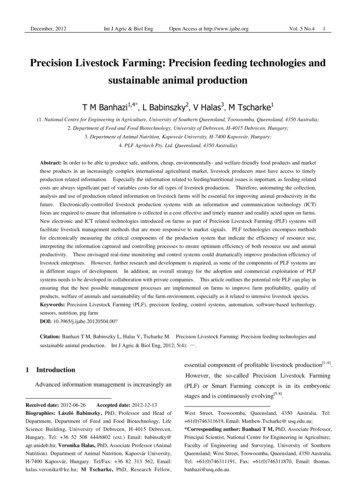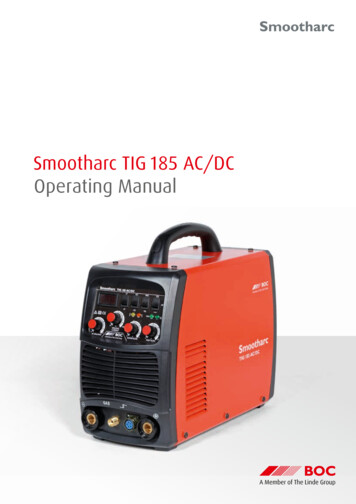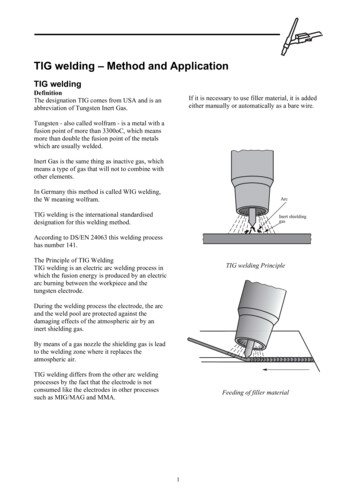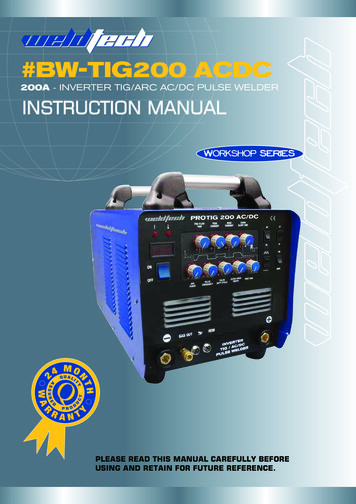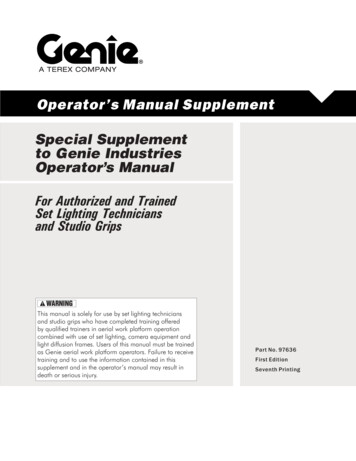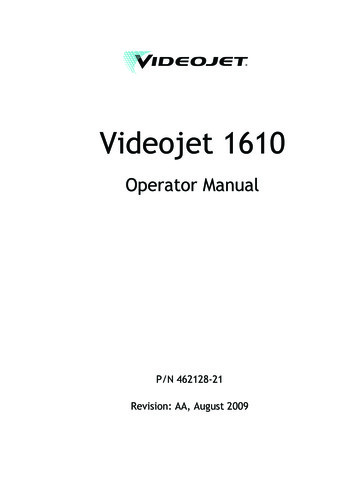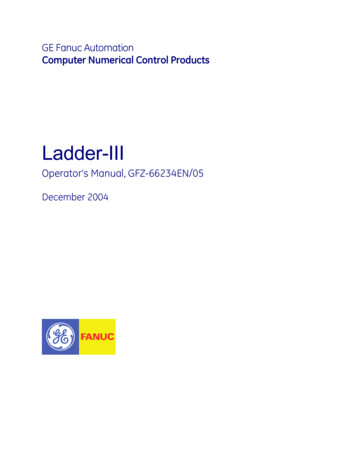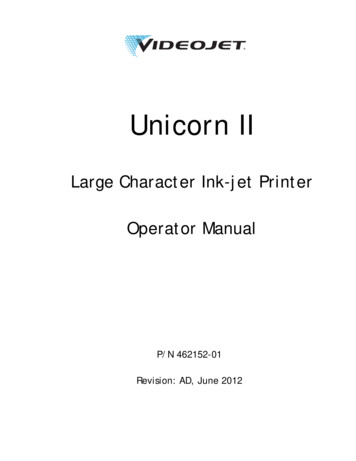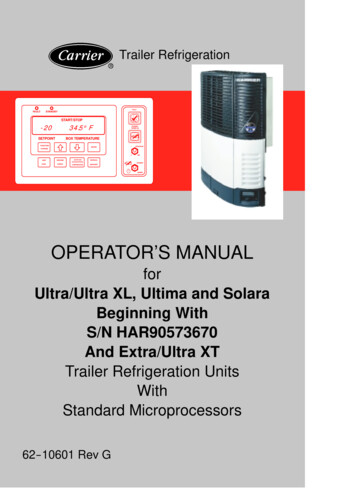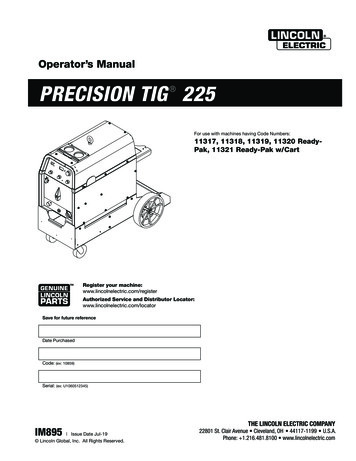
Transcription
Operator’s ManualPRECISION TIG 225 For use with machines having Code Numbers:11317, 11318, 11319, 11320 ReadyPak, 11321 Ready-Pak w/CartRegister your machine:www.lincolnelectric.com/registerAuthorized Service and Distributor Locator:www.lincolnelectric.com/locatorSave for future referenceDate PurchasedCode: (ex: 10859)Serial: (ex: U1060512345)IM895 Issue Date Jul-19 Lincoln Global, Inc. All Rights Reserved.
THANK YOU FOR SELECTINGA QUALITY PRODUCT BYLINCOLN ELECTRIC.PLEASE EXAMINE CARTON AND EQUIPMENT FORDAMAGE IMMEDIATELYWhen this equipment is shipped, title passes to the purchaserupon receipt by the carrier. Consequently, claims for materialdamaged in shipment must be made by the purchaser against thetransportation company at the time the shipment is received.SAFETY DEPENDS ON YOULincoln arc welding and cutting equipment is designed and builtwith safety in mind. However, your overall safety can be increasedby proper installation . and thoughtful operation on your part.DO NOT INSTALL, OPERATE OR REPAIR THIS EQUIPMENTWITHOUT READING THIS MANUAL AND THE SAFETYPRECAUTIONS CONTAINED THROUGHOUT. And, most importantly,think before you act and be careful.WARNINGThis statement appears where the information must be followedexactly to avoid serious personal injury or loss of life.CAUTIONThis statement appears where the information must be followedto avoid minor personal injury or damage to this equipment.KEEP YOUR HEAD OUT OF THE FUMES.DON’T get too close to the arc.Use corrective lenses if necessaryto stay a reasonable distanceaway from the arc.READ and obey the Safety DataSheet (SDS) and the warning labelthat appears on all containers ofwelding materials.USE ENOUGH VENTILATION orexhaust at the arc, or both, tokeep the fumes and gases fromyour breathing zone and the general area.IN A LARGE ROOM OR OUTDOORS, natural ventilation may beadequate if you keep your head out of the fumes (See below).USE NATURAL DRAFTS or fans to keep the fumes awayfrom your face.If you develop unusual symptoms, see your supervisor.Perhaps the welding atmosphere and ventilation systemshould be checked.WEAR CORRECT EYE, EAR &BODY PROTECTIONPROTECT your eyes and face with welding helmetproperly fitted and with proper grade of filter plate(See ANSI Z49.1).PROTECT your body from welding spatter and arcflash with protective clothing including woolenclothing, flame-proof apron and gloves, leatherleggings, and high boots.PROTECT others from splatter, flash, and glarewith protective screens or barriers.IN SOME AREAS, protection from noise may be appropriate.BE SURE protective equipment is in good condition.Also, wear safety glasses in work areaAT ALL TIMES.SPECIAL SITUATIONSDO NOT WELD OR CUT containers or materials which previouslyhad been in contact with hazardous substances unless they areproperly cleaned. This is extremely dangerous.DO NOT WELD OR CUT painted or plated parts unless specialprecautions with ventilation have been taken. They can releasehighly toxic fumes or gases.Additional precautionary measuresPROTECT compressed gas cylinders from excessive heat,mechanical shocks, and arcs; fasten cylinders so they cannot fall.BE SURE cylinders are never grounded or part of anelectrical circuit.REMOVE all potential fire hazards from welding area.ALWAYS HAVE FIRE FIGHTING EQUIPMENT READY FORIMMEDIATE USE AND KNOW HOW TO USE IT.Safety 01 of 04 - 5/16/2018
SAFETYSECTION A:WARNINGSCALIFORNIA PROPOSITION 65 WARNINGSWARNING: Breathing diesel engine exhaustexposes you to chemicals known to the Stateof California to cause cancer and birth defects,or other reproductive harm. Always start and operate the engine in awell-ventilated area. If in an exposed area, vent the exhaust to the outside. Do not modify or tamper with the exhaust system. Do not idle the engine except as necessary.For more information go towww.P65 warnings.ca.gov/dieselWARNING: This product, when used for welding orcutting, produces fumes or gases which containchemicals known to the State of California to causebirth defects and, in some cases, cancer. (CaliforniaHealth & Safety Code § 25249.5 et seq.)WARNING: Cancer and Reproductive Harmwww.P65warnings.ca.govARC WELDING CAN BE HAZARDOUS. PROTECTYOURSELF AND OTHERS FROM POSSIBLE SERIOUSINJURY OR DEATH. KEEP CHILDREN AWAY.PACEMAKER WEARERS SHOULD CONSULT WITHTHEIR DOCTOR BEFORE OPERATING.Read and understand the following safety highlights. Foradditional safety information, it is strongly recommendedthat you purchase a copy of “Safety in Welding & Cutting ANSI Standard Z49.1” from the American Welding Society,P.O. Box 351040, Miami, Florida 33135 or CSA StandardW117.2-1974. A Free copy of “Arc Welding Safety” bookletE205 is available from the Lincoln Electric Company,22801 St. Clair Avenue, Cleveland, Ohio 44117-1199.BE SURE THAT ALL INSTALLATION, OPERATION,MAINTENANCE AND REPAIR PROCEDURES AREPERFORMED ONLY BY QUALIFIED INDIVIDUALS.FOR ENGINE POWEREDEQUIPMENT.1.a. Turn the engine off before troubleshootingand maintenance work unless themaintenance work requires it to be running.with hot engine parts and igniting. Do not spill fuel when fillingtank. If fuel is spilled, wipe it up and do not start engine untilfumes have been eliminated.1.d. Keep all equipment safety guards, coversand devices in position and in good repair.Keep hands, hair, clothing and tools awayfrom V-belts, gears, fans and all othermoving parts when starting, operating orrepairing equipment.1.e. In some cases it may be necessary to remove safety guards toperform required maintenance. Remove guards only whennecessary and replace them when the maintenance requiringtheir removal is complete. Always use the greatest care whenworking near moving parts.1.f. Do not put your hands near the engine fan. Do not attempt tooverride the governor or idler by pushing on the throttle controlrods while the engine is running.1.g. To prevent accidentally starting gasoline engines while turningthe engine or welding generator during maintenance work,disconnect the spark plug wires, distributor cap or magneto wireas appropriate.1.h. To avoid scalding, do not remove the radiatorpressure cap when the engine is hot.ELECTRIC ANDMAGNETIC FIELDS MAYBE DANGEROUS2.a. Electric current flowing through any conductorcauses localized Electric and Magnetic Fields (EMF).Welding current creates EMF fields around welding cablesand welding machines2.b. EMF fields may interfere with some pacemakers, andwelders having a pacemaker should consult their physicianbefore welding.2.c. Exposure to EMF fields in welding may have other health effectswhich are now not known.2.d. All welders should use the following procedures in order tominimize exposure to EMF fields from the welding circuit:2.d.1. Route the electrode and work cables together - Securethem with tape when possible.2.d.2. Never coil the electrode lead around your body.2.d.3. Do not place your body between the electrode and workcables. If the electrode cable is on your right side, thework cable should also be on your right side.2.d.4. Connect the work cable to the workpiece as close as possible to the area being welded.2.d.5. Do not work next to welding power source.1.b. Operate engines in open, well-ventilated areas or vent the engineexhaust fumes outdoors.1.c. Do not add the fuel near an open flame weldingarc or when the engine is running. Stop theengine and allow it to cool before refueling toprevent spilled fuel from vaporizing on contactSafety 02 of 04 - 5/16/2018
SAFETYELECTRIC SHOCKCAN KILL.ARC RAYS CAN BURN.3.a. The electrode and work (or ground) circuits areelectrically “hot” when the welder is on. Donot touch these “hot” parts with your bare skin or wet clothing.Wear dry, hole-free gloves to insulate hands.4.a.Use a shield with the proper filter and cover plates to protect youreyes from sparks and the rays of the arc when welding orobserving open arc welding. Headshield and filter lens shouldconform to ANSI Z87. I standards.3.b. Insulate yourself from work and ground using dry insulation.Make certain the insulation is large enough to cover your full areaof physical contact with work and ground.4.b.Use suitable clothing made from durable flame-resistant materialto protect your skin and that of your helpers from the arc rays.4.c.Protect other nearby personnel with suitable, non-flammablescreening and/or warn them not to watch the arc nor exposethemselves to the arc rays or to hot spatter or metal.In addition to the normal safety precautions, ifwelding must be performed under electricallyhazardous conditions (in damp locations or whilewearing wet clothing; on metal structures such asfloors, gratings or scaffolds; when in crampedpositions such as sitting, kneeling or lying, if thereis a high risk of unavoidable or accidental contactwith the workpiece or ground) use the followingequipment: Semiautomatic DC Constant Voltage (Wire) Welder. DC Manual (Stick) Welder. AC Welder with Reduced Voltage Control.3.c. In semiautomatic or automatic wire welding, the electrode,electrode reel, welding head, nozzle or semiautomatic weldinggun are also electrically “hot”.3.d. Always be sure the work cable makes a good electricalconnection with the metal being welded. The connection shouldbe as close as possible to the area being welded.3.e. Ground the work or metal to be welded to a good electrical (earth)ground.3.f. Maintain the electrode holder, work clamp, welding cable andwelding machine in good, safe operating condition. Replacedamaged insulation.3.g. Never dip the electrode in water for cooling.3.h. Never simultaneously touch electrically “hot” parts of electrodeholders connected to two welders because voltage between thetwo can be the total of the open circuit voltage of bothwelders.3.i. When working above floor level, use a safety belt to protectyourself from a fall should you get a shock.3.j. Also see Items 6.c. and 8.FUMES AND GASESCAN BE DANGEROUS.5.a. Welding may produce fumes and gaseshazardous to health. Avoid breathing thesefumes and gases. When welding, keep your head out of the fume.Use enough ventilation and/or exhaust at the arc to keep fumesand gases away from the breathing zone. When weldinghardfacing (see instructions on container or SDS)or on lead or cadmium plated steel and othermetals or coatings which produce highly toxicfumes, keep exposure as low as possible andwithin applicable OSHA PEL and ACGIH TLV limitsusing local exhaust or mechanical ventilationunless exposure assessments indicate otherwise.In confined spaces or in some circumstances,outdoors, a respirator may also be required.Additional precautions are also required whenweldingon galvanized steel.5. b. The operation of welding fume control equipment is affected byvarious factors including proper use and positioning of theequipment, maintenance of the equipment and the specificwelding procedure and application involved. Worker exposurelevel should be checked upon installation and periodicallythereafter to be certain it is within applicable OSHA PEL andACGIH TLV limits.5.c. Do not weld in locations near chlorinated hydrocarbon vaporscoming from degreasing, cleaning or spraying operations. Theheat and rays of the arc can react with solvent vapors to formphosgene, a highly toxic gas, and other irritating products.5.d. Shielding gases used for arc welding can displace air and causeinjury or death. Always use enough ventilation, especially inconfined areas, to insure breathing air is safe.5.e. Read and understand the manufacturer’s instructions for thisequipment and the consumables to be used, including theSafety Data Sheet (SDS) and follow your employer’s safetypractices. SDS forms are available from your weldingdistributor or from the manufacturer.5.f. Also see item 1.b.Safety 03 of 04 - 5/16/2018
SAFETYWELDING AND CUTTINGSPARKS CAN CAUSEFIRE OR EXPLOSION.6.a. Remove fire hazards from the welding area. Ifthis is not possible, cover them to prevent the welding sparksfrom starting a fire. Remember that welding sparks and hotmaterials from welding can easily go through small cracks andopenings to adjacent areas. Avoid welding near hydraulic lines.Have a fire extinguisher readily available.6.b. Where compressed gases are to be used at the job site, specialprecautions should be used to prevent hazardous situations.Refer to “Safety in Welding and Cutting” (ANSI Standard Z49.1)and the operating information for the equipment being used.6.c. When not welding, make certain no part of the electrode circuit istouching the work or ground. Accidental contact can causeoverheating and create a fire hazard.6.d. Do not heat, cut or weld tanks, drums or containers until theproper steps have been taken to insure that such procedureswill not cause flammable or toxic vapors from substances inside.They can cause an explosion even though they have been“cleaned”. For information, purchase “Recommended SafePractices for the Preparation for Welding and Cutting ofContainers and Piping That Have Held Hazardous Substances”,AWS F4.1 from the American Welding Society(see address above).6.e. Vent hollow castings or containers before heating, cutting orwelding. They may explode.6.f. Sparks and spatter are thrown from the welding arc. Wear oil freeprotective garments such as leather gloves, heavy shirt, cufflesstrousers, high shoes and a cap over your hair. Wear ear plugswhen welding out of position or in confined places. Always wearsafety glasses with side shields when in a welding area.6.g. Connect the work cable to the work as close to the welding areaas practical. Work cables connected to the building framework orother locations away from the welding area increase thepossibility of the welding current passing through lifting chains,crane cables or other alternate circuits. This can create firehazards or overheat lifting chains or cables until they fail.6.h. Also see item 1.c.6.I. Read and follow NFPA 51B “Standard for Fire Prevention DuringWelding, Cutting and Other Hot Work”, available from NFPA, 1Batterymarch Par
16.05.2018 · ANSI Standard Z49.1” from the American Welding Society, P.O. Box 351040, Miami, Florida 33135 or CSA Standard W117.2-1974. A Free copy of “Arc Welding Safety” booklet E205 is available from the Lincoln Electric Company, 22801 St. Clair Avenue, Cleveland, Ohio 44117-1199. BE SURE THAT ALL INSTALLATION, OPERATION, MAINTENANCE AND REPAIR PROCEDURES ARE PERFORMED
